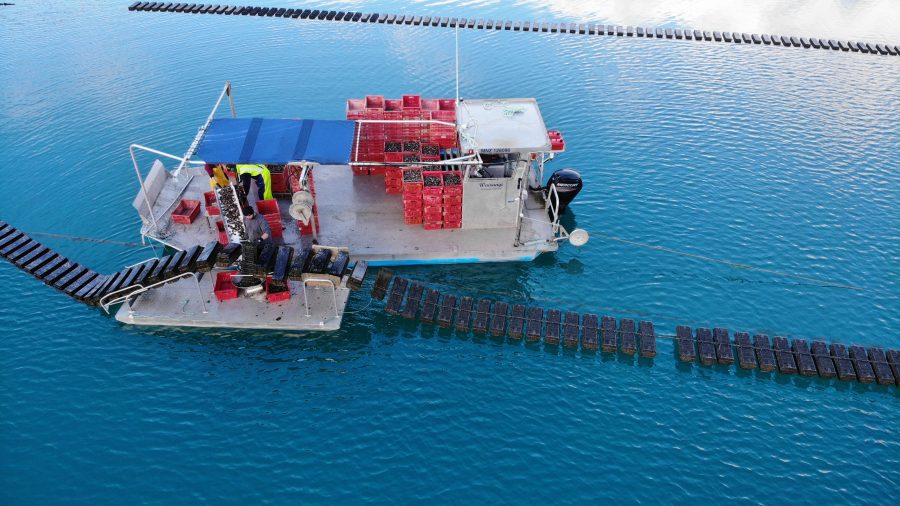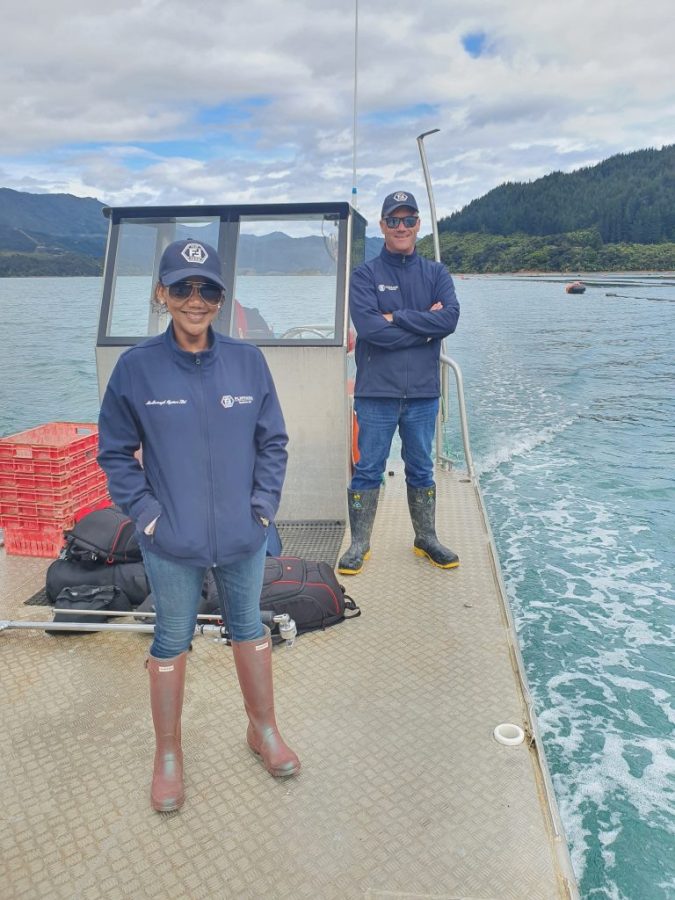
“We built the system for us but once we saw that it worked we knew it was going to solve a big problem for farmers around the world. Still, we didn’t know how people would react to it. We just put it out there.”
— Aaron Pannell, FlipFarm
“FlipFarm wasn’t driven by innovation,” says Pannell. “Our first priority was to stop losing our gear and our oysters. That was the motivation for coming up with a better system. The stormy weather in this part of the world and our isolated location had a big influence on the development and design of FlipFarm.”
“Apart from the challenges Mother Nature threw at us, we were also short-staffed. Oyster farming is tough, hard work and it has traditionally been a male-dominated industry. It’s dirty, uncomfortable, backbreaking work. Each growing bag has to be handled individually, multiple times. Staff turnover and burnout is high and I found myself working 12-hour days, six days a week. Something had to give or something had to change.”
Pannell’s oyster farm in Croisilles Harbour in Marlborough Sounds is at the end of a long and winding road, which is appropriate considering his journey to becoming an Agritech entrepreneur.
“Farming is in my blood,” he says. “I grew up on a sheep farm and I’ve always been passionate about primary production. Before I got into aquaculture I worked on dairy farms in New Zealand’s South Island. When you work on a farm you learn how to fix things and make do with what you have. Without overemphasising the ‘number 8 wire mentality’, Kiwis definitely have a knack for problem-solving creativity. We’re constantly looking for new ways of doing things.”
Pannell came up with a new method for growing and harvesting oysters that reduced wear and tear on the equipment, provided an ideal environment for oyster growing and conditioning, while also controlling pests and predators.
“It reduced our workload significantly and made it much easier to find suitable staff,” he says. “It also changed the demographic of the staff we can employ. The beauty of the FlipFarm system is it opens doors for people who might not have considered oyster farming before because it was too physically demanding. The machinery is safe and easy to operate and it makes life easier for people working in the industry which is very satisfying.”
“We built the system for us but once we saw that it worked we knew it was going to solve a big problem for farmers around the world. We didn’t know how people would react to it. We just put it out there.”
“We did things differently to a lot of startups. When we started we didn’t have a sales and marketing strategy. We didn’t even have a website. I don’t think you need a global strategy until you start getting a lot of interest. Instead, we invested a lot of time and energy into perfecting the system.”

Connecting to the oyster world
One of Pannell’s key suppliers had a database of oyster farmers around the world and they sent an email to their customers with a YouTube video of the system operating on his farm. He got all these replies from oyster farmers desperate to get their hands on the gear. Keith Butterfield, an oyster farmer in Maine, USA, was one of those who watched the mesmerising footage on YouTube. The automated efficiency of the FlipFarm system was in stark contrast to what he was used to in the US.
“I was just blown away as I watched it,” he says. “I kept saying to myself, ‘Is this real?’ Because there’s nothing like this in the US. New Zealand is way ahead of the US when it comes to aquaculture. We’re farming on the water like it’s the early 19th century, heading out into the field with a wheelbarrow and a shovel. It’s changing though.”
“Mechanisation has transformed the way we farm the land and we desperately need to farm our seas more efficiently and sustainably. We’re seeing a lot of people with different backgrounds coming into the industry who are really concerned about the ocean and how we’re treating it. I’m one of those people. I came from the medical devices industry and I started oyster farming as a hobby. But I learned the more shellfish, algae and kelp products we can grow on the water, the better it is for the marine ecosystem and for carbon sequestration.”
Caring for the environment is one thing but If you’re using manual labour to farm oysters you are severely limited to how many oysters you can harvest. Watching the FlipFarm video, Butterfield realised it could dramatically reduce the labour hours and allow small oyster farmers to build a sustainable business. He jumped on a plane to New Zealand to check out the system for himself and was impressed by Pannell’s engineering brain and his number 8 wire approach to the solution.
“When you can take that fix it mentality and build something for your own farm, that’s great. But when you create something that changes the game for everyone else, then you’ve done something really special. That’s what Aaron has done. He’s given us a gift.”
“The old way of farming oysters was hard labour. This system gives oyster farmers more money and time. It’s perfect for small family farms who can now build a sustainable business. It’s going to change lives.”
The FlipFarm system is now used by more than 70 farmers in 12 countries worldwide and won the 2021 Global Seafood Alliance Aquaculture Innovation Award.
Do your homework before taking on the world
 Pannell’s advice to other entrepreneurs is to do as much research as you can before going to market.
Pannell’s advice to other entrepreneurs is to do as much research as you can before going to market.
“While I was developing the system. I spent a huge amount of time researching the industry,” he says. “By research I don’t mean the size of the market or who your customers are or how much you’re going to charge. Learn about the industry and the real problems on the ground.
“I had a massive advantage because I had 30 years experience in aquaculture. I lived with the problem, trialled different solutions and tested them on our farm. This is the eighth growing system I’ve tried. I launched two others that didn’t take off but all the time I was drawing on all of those little things I learned along the way and some I’d forgotten.”
“A lot of people invent solutions and then go looking for a problem to apply it to. I’m a firm believer in finding the problem and then coming up with a solution. Innovation can come from anywhere. People on the edges of an industry can come up with some really good ideas but usually the ones that work come from people who have a close connection to the problem they’re trying to solve.”